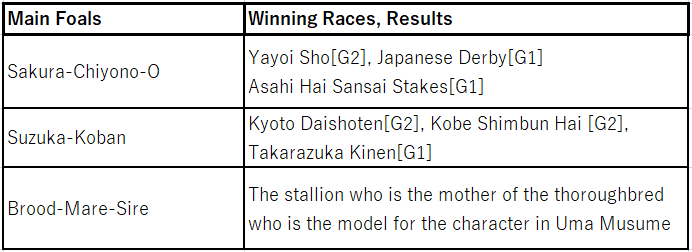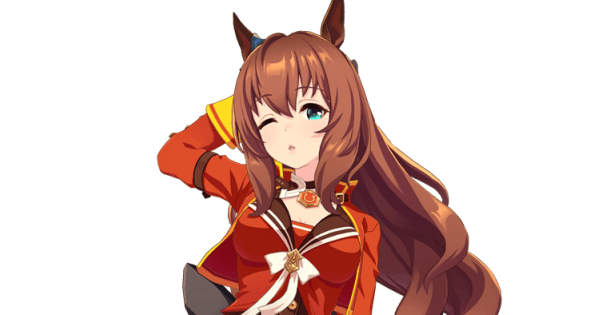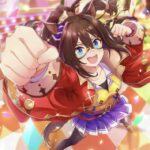Maruzensky [マルゼンスキー]


- About Uma Musume
- Overview
- 1. Her nickname is “Supercar”
- 2. She doesn’t live in a dormitory and lives alone
- 3. About her Secret
- 4. Voiced by Lynn・The voice actress is Lynn・She is mix of Amerian and Japanese・Her representative works are ” Mushoku Tensei Jobless Reincarnation” (Lilya Gray Rat), ” That Time I Got Reincarnated as a Slime” (Luminous Valentine), etc.
- Overview
- About the racehorse that served as the model
- Next・・・・
About Uma Musume
Overview

Point
・Nickname: “The Supercar”
・She doesn’t live in dormitory and lives alone
・About her secret
・Voiced by Lynn
1. Her nickname is “Supercar”
・The racehorse she was modeled after was also called “Supercar”
・The name “Supercar” named from the fact that Maruzensky was a horse brought in from overseas and his overwhelming speed.
・The name of Marzensky’s skill in the game, “Red Flame Gear/LP1211-M(紅焔ギア/LP1211-M),” is also thought to be a reference to that foreign car, the Lamborghini.

2. She doesn’t live in a dormitory and lives alone
・It is thought that this setting was chosen because the training center where the dormitory was originally located was not open at this time.


3. About her Secret
・Rarely for Uma-Musume, she does not belong to a dormitory and lives alone.
・In the Uma Musume game, the word “Nata-de-coco” appears as one of Marzenski’s secrets.
・Nata de coco is a traditional Southeast Asian fermented food made by fermenting coconut juice with nata bacteria, a type of acetic acid bacteria, and became popular among young people in Japan in the 1980s.
・If Maruzensky were a human in the 1980s, she would be in junior high school or college, and thus be a direct descendant of the generation that was hit by the nata-de-coco.


4. Voiced by Lynn・The voice actress is Lynn・She is mix of Amerian and Japanese・Her representative works are ” Mushoku Tensei Jobless Reincarnation” (Lilya Gray Rat), ” That Time I Got Reincarnated as a Slime” (Luminous Valentine), etc.
About the racehorse that served as the model
Overview

Father: Nijinsky [CAN] Mother: Shill [Maternal Father: Buckpasser]
Birth – Death: May. 19. 1974 – Aug. 21. 1997 [23 years old].
Major Results (Grade at the time)

The Impact of Horse Racing on Developing Countries
A high obstacle called ” Brought-in horse”
When a mother is bred to a stallion outside of Japan and the foal is born in Japan, the foal is called a “Brought-in horse. Before Maruzensky, there were eight major race winners who were Brought-in horses, but with the trade liberalization in 1971, a policy of protection was implemented for domestic producers. From 1976 to 1977, only 11.7% of the races were open to horses of any origins, and from 1984, horses of any origins regained the same status as domestic horses. Therefore, Maruzensky was a Thoroughbred who was active just at the time when it was difficult for owners to run their own horses.
The big Gap between horse racing in Japan at that time and the rest of the world
Nowadays, it is not unusual for Japanese horses to compete in overseas races, such as competing in the Prix de l’Arc de Triomphe and finishing in the top positions. In addition, the standard of stallions, such as Deep-Impact, is said to be the highest in the world. However, when Maruzensky was born, there was a big gap between Japan and the rest of the world. Japanese horses were far below the abilities of the world’s major countries, and their bloodlines were also inferior. Therefore, the arrival of Maruzensky, who is descended from the famous horse Nijinsky, was such a shock that some people said it was like an F1 car participating in a race for production cars.


Racehorse period
Debut
The race was held in October at Nakayama. At first, he was not well received due to leg anxiety and the fact that some of the same horses were brought in at a higher price than Maruzensky. From the start, Marzensky immediately took the lead and won the race for the first time by a large margin (over 10 lengths) and by 2 seconds in time. However, the trainer said that he had kept the pace down, and the result was that he was able to run away with the race due to the difference in speed from the other horses.
Junior Races
Fuchu Sansai Stakes[OP]<Nov.1976>: He was the overwhelming top favorite with odds of 1.1x. The jockey, who was enthralled by Maruzensky’s ability, ran a monotonous race, saying, “Just wait for the other horse to come at you and spur him on.” Midway down the final straight, a rival horse came alongside at once, and he hurriedly drove Maruzensky out. As a result, Maruzensky and the rival horse engaged in a fierce competition, and as a result of a photo finish, Maruzensky won by a nose.
Asahi Hai Sansai Stakes[OP]<Dec.1976>: Learning a lesson from the previous race, the Maruzensky camp decided to give it their all and entered the Asahi Hai Sansai Stakes, the race to determine the 3-year-old champion. In the race, Maruzensky always took the lead from the start and won by 13 lengths, or 2.2 seconds, over the second-placed horse. The time was also a new record at the time. There is a story that Maruzensky was called a “The Monster” in Uma Musume. He won four races and was named the best 3-year-old stallion.
It is the movie of Asahi Hai Sansai Stakes[OP] in Dec.1976. The language in the movie is only Japanese. The number 6 is Maruzensky.
Classic era
4 Years old (January 1977): He registered for the open race at Chukyo Racecourse in order to run in the Kisaragi Sho, but when word got out that Maruzensky was going to run in the race, a number of horses canceled their entries, and for a while, it looked as if the race might not be held because of lack of joining horses at the race. As a result, two horses entered the race just before the start, and the race was approved. The result was a victory by 2 1/2 lengths over the second-place finisher. However, Maruzensky broke his knee after this race and had to take a three-month rest.
Nihon Tampa Sho[OP] (June 1977): Maruzensky ran in Nihon Tampa-Sho, also known as the “Shame Derby”. The reason why the race was said is that the horses that didn’t win “Japanese Derby” could join the race at that time. On the race day, nearly 80,000 spectators gathered at Nakayama Racecourse to see him. Although a horse named Press-Toko, winner of the Derby trial NHK Cup, was also entered in this race, Maruzensky’s odds to win the race were 1.0x throughout the race. Maruzensky easily took the lead at the start of the race, and by the first turn was already six or seven lengths in front of second place, although he suddenly raised his head high and stalled out between the third and final turn, he eventually won by seven lengths over Press-Toko in third. Press-Toko later won St. Light Kinen and the Kyoto Shinbun-Hai in the fall, and then the Kikka-Sho.
Tankyori(Short-track) Stakes[OP](July 1977): Maruzensky was the first horse to run in the second position. The first 600 meters of the first half of the race was run at an abnormally fast pace of 33.2 seconds, despite the deep sand of the Sapporo dirt at the time. The time was a record time.
Senior Races
After the Short(Short-track) Stakes:
However, around the time of the Short Stakes, Maruzensky’s legs were in a disturbing state. He also later developed flexor tendonitis due to a collision with an offence during a training session. He was sent out to pasture and returned to the stable in early October. Eventually, he will go straight to the Arima-Kinen (The Grand Prix).
Arima-Kinen ( The Grand Prix), then…
Maruzensky was voted fourth in the Arima-Kinen fan poll. He was expected to run in the race, but his flexor tendonitis recurred in his final training session. The veterinarian diagnosed that the symptoms were mild and Maruzensky could run, but the trainer judged that he was in pain because Maruzensky raised his leg when he tried to put his hand on it. The decision was made to avoid running the race. Although his flexor tendonitis was mild, Marzenski had no other target races to run except the Takarazuka-Kinen and Arima-Kinen, so he was retired to be used as a stallion. In total, he won eight races and finished second by a total of 61 lengths.
Unable to Run in the Japanese-Derby
Maruzensky was not eligible to run in the Japanese Derby because of his origins as a carry-in horse. On the week of the Derby, Maruzensky’s jockey said, “I want him to run in the Japanese Derby. I won’t interfere with other horses at all. We don’t even need the prize money. All I want is to confirm the horse’s ability.” Maruzensky’s trainer was considering a trial, but due to a variety of circumstances, the race was ruled out of the Derby. Incidentally, from this episode, in the game Uma Musume Pretty Derby, the Japanese Derby in which Maruzensky participates in the story is fixed to start from the biggest outside, which is said to be disadvantageous. The trainer received several letters from fans asking why he gave up so easily and why he did not sue. In response, the JRA(Japanese Racing Association) introduced a policy of easing the restrictions on the number of races a horse could run in, such as increasing the number of races in which a horse could run in a “Grade race” from 11 to 78. However, the Japan Light Breeders’ Association, a racehorse producer’s organization, objected vehemently to this policy, and in the end, the policy was withdrawn entirely, and the next year, 1978, the same as before. The issue of Maruzensky’s failure to compete in the Derby was discussed in the public relations magazine of the organizer, the Japanese Racing Association.
Stallion Period
*Names and grades are current.

Maruzensky became a stallion at the Toyosato Stallion Center in Monbetsu, Hokkaido. In Europe and the United States, the children of Northern-Dancer, Maruzensky’s paternal grandfather, were winning major races at a furious pace and were rapidly rewriting the pedigree map. Because Maruzensky’s grandfather, Northern-Dancer, was the first horse in Japan to demonstrate the excellence of his bloodline, he attracted a great deal of attention and expectation from the breeding community. Maruzensky lived up Sakura-Chiyono-O to these expectations, passing on his speed, quickness, and untested stamina to his offspring, who went on to win GI races such as the Asahi Hai Sansai Stakes (Asahi Cup 3-Year-Old Stakes) and the Japan Derby, which Maruzensky was never able to accomplish.



His stallion performance was highly evaluated, and in 1990, he was selected as a JRA honored horse. The Maruzensky bloodline has been passed on to his grandchildren and onward. Special-Week, Winning-Ticket, Rice-Shower, and Mejiro-Bright, who appear in Uma- Musume, are Maruzensky’s grandchildren, and Curren-Chan is his great-granddaughter.
His grandson Special Week’s rival, Glass Wonder, won the Asahi Cup in record time and was called “the second coming of Marzenski” for his performance and position in the race.





Next・・・・
The Golden Generation of Japanese Horse Racing
In the next issue, we will introduce the 1997-1998 generation of Uma Musume, the golden generation of Japanese horse racing.
Enjoy!
Please feel free to leave your comments!









コメント